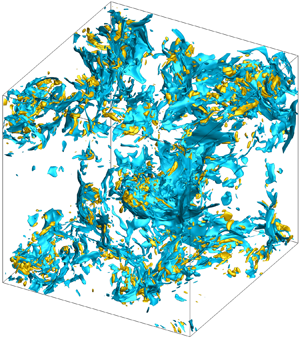Article contents
Transfer of internal energy fluctuation in compressible isotropic turbulence with vibrational non-equilibrium
Published online by Cambridge University Press: 27 May 2021
Abstract

The transfer of internal energy fluctuation is numerically investigated for the stationary compressible isotropic turbulence in vibrational non-equilibrium with large-scale thermal forcing. We observe the spectra of velocity, solenoidal pressure component, density and temperatures all exhibiting the  $k^{-5/3}$ scaling in the inertial range. The Helmholtz decomposition results reveal that the solenoidal velocity component predominates over the dilatational component. Fluctuations of the solenoidal velocity and pressure components are nearly insensitive to the turbulent Mach number and vibrational relaxation, while those of the dilatational velocity and pressure components are closely related to them. In addition, the weak and strong acoustic equilibrium hypotheses are verified. On global average, the dissipation of translational–rotational energy fluctuation stems mainly from the thermal conduction and vibrational relaxation, while effects of the dilatation and viscosity are negligible. For the vibrational energy fluctuation, the dilatation effect is insignificant, while the dissipation due to the thermal conduction is roughly equivalent to the production owing to the vibrational relaxation. The cascades of translational–rotational and vibrational energy fluctuations are mainly dominated by the solenoidal component of filtered velocity. The direct subgrid-scale (SGS) fluxes of translational–rotational and vibrational energy fluctuations due to the dilatational component of filtered velocity in the compression region are balanced by the reverse SGS fluxes in the expansion region. On the other hand, the dependencies of the SGS fluxes due to the solenoidal component of filtered velocity on the local compressibility are closely related to the relaxation effect. The sensibility gradually disappears as the relaxation effect weakens.
$k^{-5/3}$ scaling in the inertial range. The Helmholtz decomposition results reveal that the solenoidal velocity component predominates over the dilatational component. Fluctuations of the solenoidal velocity and pressure components are nearly insensitive to the turbulent Mach number and vibrational relaxation, while those of the dilatational velocity and pressure components are closely related to them. In addition, the weak and strong acoustic equilibrium hypotheses are verified. On global average, the dissipation of translational–rotational energy fluctuation stems mainly from the thermal conduction and vibrational relaxation, while effects of the dilatation and viscosity are negligible. For the vibrational energy fluctuation, the dilatation effect is insignificant, while the dissipation due to the thermal conduction is roughly equivalent to the production owing to the vibrational relaxation. The cascades of translational–rotational and vibrational energy fluctuations are mainly dominated by the solenoidal component of filtered velocity. The direct subgrid-scale (SGS) fluxes of translational–rotational and vibrational energy fluctuations due to the dilatational component of filtered velocity in the compression region are balanced by the reverse SGS fluxes in the expansion region. On the other hand, the dependencies of the SGS fluxes due to the solenoidal component of filtered velocity on the local compressibility are closely related to the relaxation effect. The sensibility gradually disappears as the relaxation effect weakens.
JFM classification
Information
- Type
- JFM Papers
- Information
- Copyright
- © The Author(s), 2021. Published by Cambridge University Press
References
REFERENCES
- 17
- Cited by


